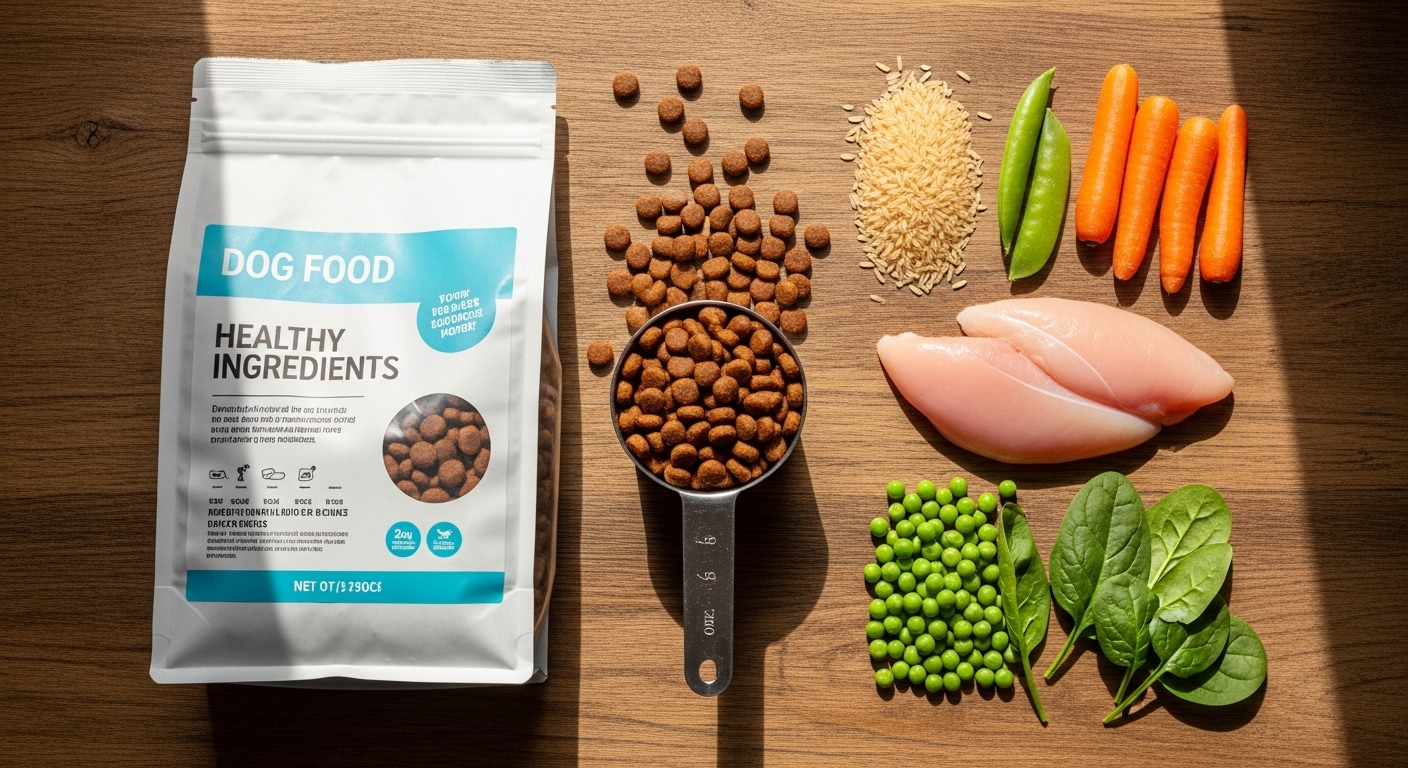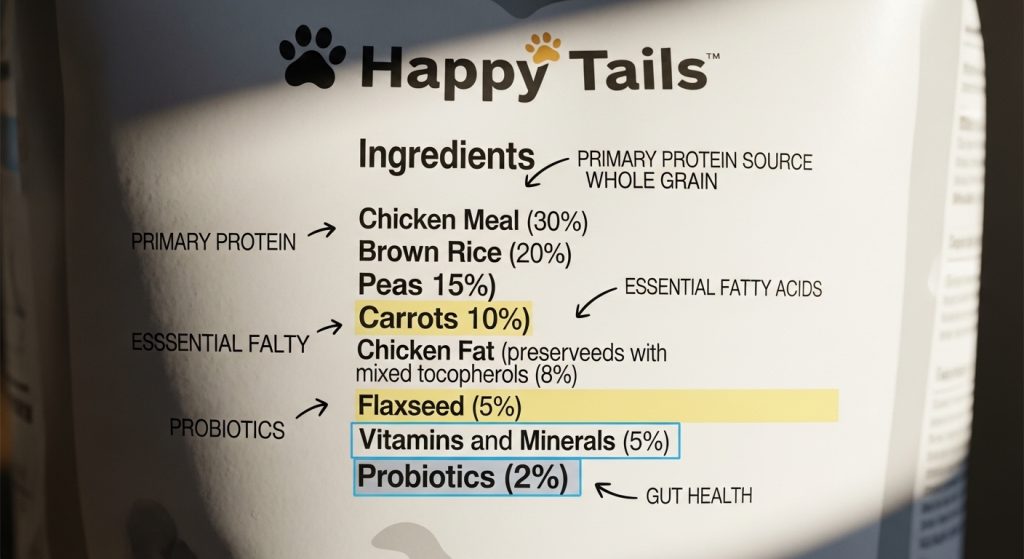Have you ever stood in front of a wall of dog food bags, overwhelmed by the labels claiming “all-natural,” “grain-free,” or “premium protein”? You’re not alone. Understanding dog food labels can be confusing, even for experienced pet owners.
Manufacturers often use marketing buzzwords that sound healthy but don’t always mean what you think. The truth is, the ingredients and nutritional information on the label reveal much more about your dog’s food quality than the brand name or price tag.
In this article, we’ll break down how to read and understand dog food labels — what each section really means, what ingredients to look for (and avoid), and how to choose the best food for your furry friend.
Decoding the Dog Food Label
What the Label Legally Must Include
Dog food packaging is regulated by organizations such as AAFCO (Association of American Feed Control Officials) in the United States, which ensures pet food meets minimum nutritional standards. According to AAFCO, every label must include:
-
Product name
-
Net weight
-
Manufacturer’s information
-
Ingredient list
-
Guaranteed analysis (protein, fat, fiber, moisture)
-
Feeding instructions
Understanding these sections helps you see past the marketing claims and focus on real nutrition.
Product Name Tricks
The product name can tell you a lot — if you know how to interpret it. For example:
-
“Beef Dog Food” means beef makes up at least 70% of the total ingredients.
-
“Dog Food with Beef” contains only 3% beef.
-
“Beef Flavor Dog Food” may have no actual beef, only flavoring.
So, always look for clear, honest labeling when choosing your dog’s diet.
Ingredient List — What Comes First Matters
Ingredients are listed in order by weight before cooking. Since water adds weight, fresh meats appear at the top but may contribute less protein after moisture is removed. Look for:
-
Named meat sources (chicken, beef, lamb, salmon) instead of vague terms like “meat meal.”
-
Whole grains such as brown rice or oats.
-
Avoid artificial colors, flavors, and preservatives like BHA, BHT, or ethoxyquin.
Guaranteed Analysis
This section tells you the minimum percentages of protein and fat, and maximum percentages of fiber and moisture.
-
Crude Protein — indicates total protein content (but not quality).
-
Crude Fat — shows fat level for energy and coat health.
-
Crude Fiber — affects digestion; moderate levels are best.
-
Moisture — high moisture means more water, less concentrated nutrition.
What’s Really Inside – Ingredients That Matter
1. Understanding Protein Sources
Protein is essential for muscle development and energy. Look for specific animal proteins like chicken, turkey, lamb, salmon, or beef. Avoid vague terms such as “animal by-products” or “meat meal” unless the source is clearly defined.
High-quality dog foods use named proteins as the first ingredient, followed by nutritious grains, vegetables, and oils.
2. The Truth About Grains
Grain-free dog food has become popular, but it’s not always healthier. Some grains like oats, barley, and brown rice provide valuable nutrients and fiber. Grain-free formulas often replace grains with starches like peas or potatoes, which can increase carbohydrates and calories.
Unless your dog has a confirmed grain allergy, wholesome grains are beneficial for digestion and sustained energy.
3. Fats and Oils for a Shiny Coat
Healthy fats are vital for your dog’s skin, coat, and brain function. Look for ingredients like:
-
Salmon oil or flaxseed oil — rich in omega-3 fatty acids
-
Chicken fat — good source of energy and taste
-
Avoid hydrogenated oils or animal fat (unspecified source)
4. Vitamins, Minerals, and Additives
A balanced dog food should contain:
-
Essential vitamins (A, D, E, K)
-
Minerals (zinc, iron, calcium, magnesium)
-
Probiotics for gut health
Avoid foods with artificial coloring or sweeteners — they serve no nutritional purpose and may cause sensitivities.
5. Reading the “Guaranteed Nutrient Levels”
Sometimes manufacturers go beyond AAFCO minimums and list specific nutrient levels. This is a great sign — it shows transparency and commitment to quality nutrition.
Choosing the Right Food for Your Dog
Consider Age, Breed, and Lifestyle
Not all dog foods fit every dog. Your dog’s nutritional needs depend on age, breed, size, and activity level.
-
Puppies: need more protein and fat for growth
-
Adults: balanced formula for maintenance
-
Seniors: fewer calories, more joint-supporting nutrients like glucosamine
Large breeds need formulas supporting bone health, while small breeds require smaller kibble and higher energy density.
Understand “Complete and Balanced” Labels
If the label states “complete and balanced”, it means the food provides all essential nutrients according to AAFCO standards. This is important — it ensures your dog won’t miss out on key vitamins or minerals.
Don’t Be Fooled by Marketing Terms
Be cautious of words like “premium,” “natural,” or “holistic”. These terms aren’t strictly regulated. Always focus on the ingredient list and nutritional breakdown, not just fancy packaging or price.
Rotate Protein Sources Occasionally
Just like humans, dogs benefit from variety. Rotating between different proteins (chicken, salmon, lamb) can prevent allergies and provide a more diverse nutrient profile.
When in Doubt, Consult Your Vet
Your veterinarian can recommend diets tailored to your dog’s health — for example, formulas for allergies, sensitive stomachs, or weight management.
A professional opinion ensures your pet gets the nutrients they need without unnecessary fillers or allergens.
Understanding dog food labels isn’t just about decoding terms — it’s about making informed choices for your pet’s health. By reading beyond marketing language and focusing on real ingredients, you’ll ensure your dog enjoys a long, healthy, and happy life.




